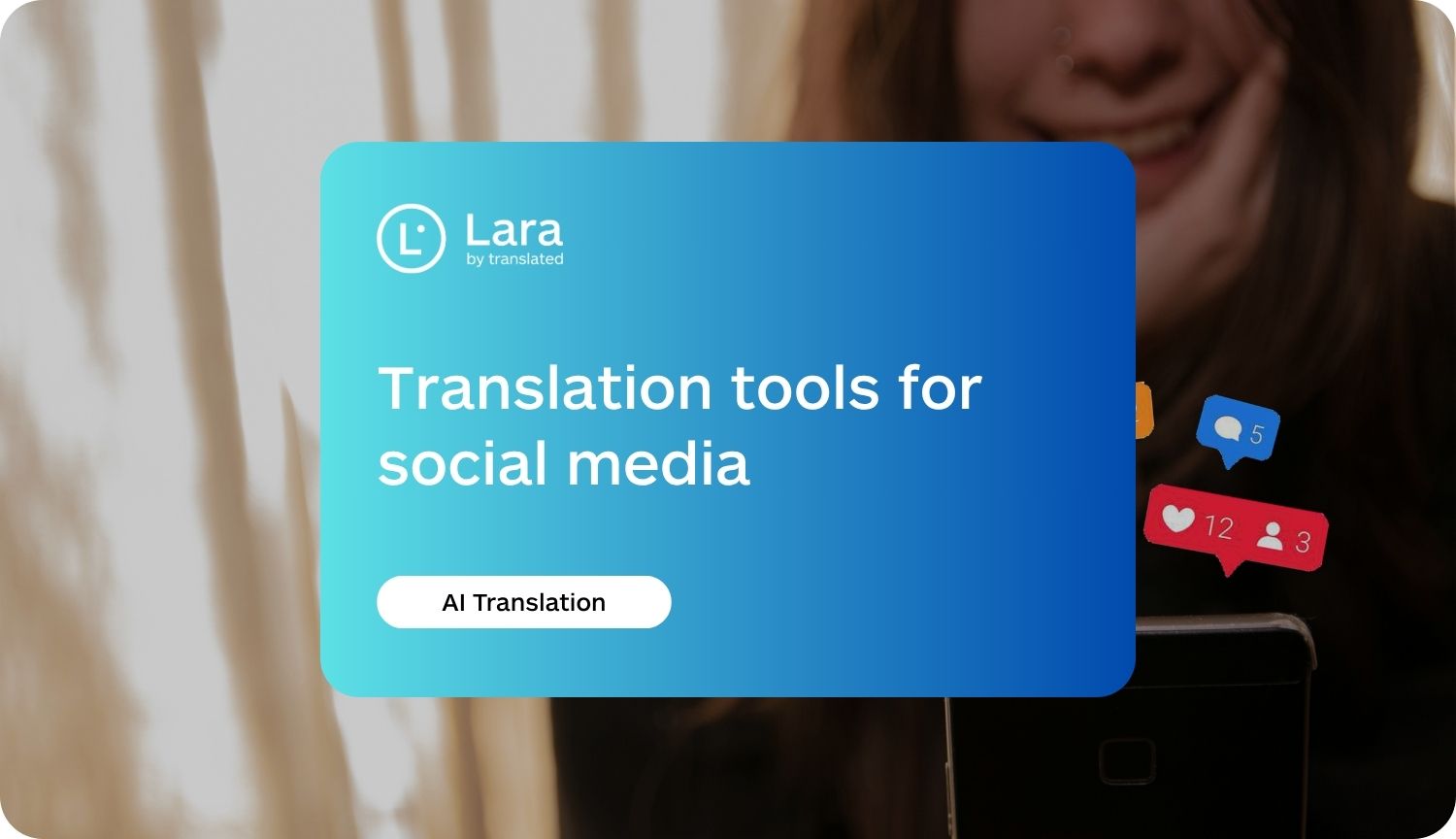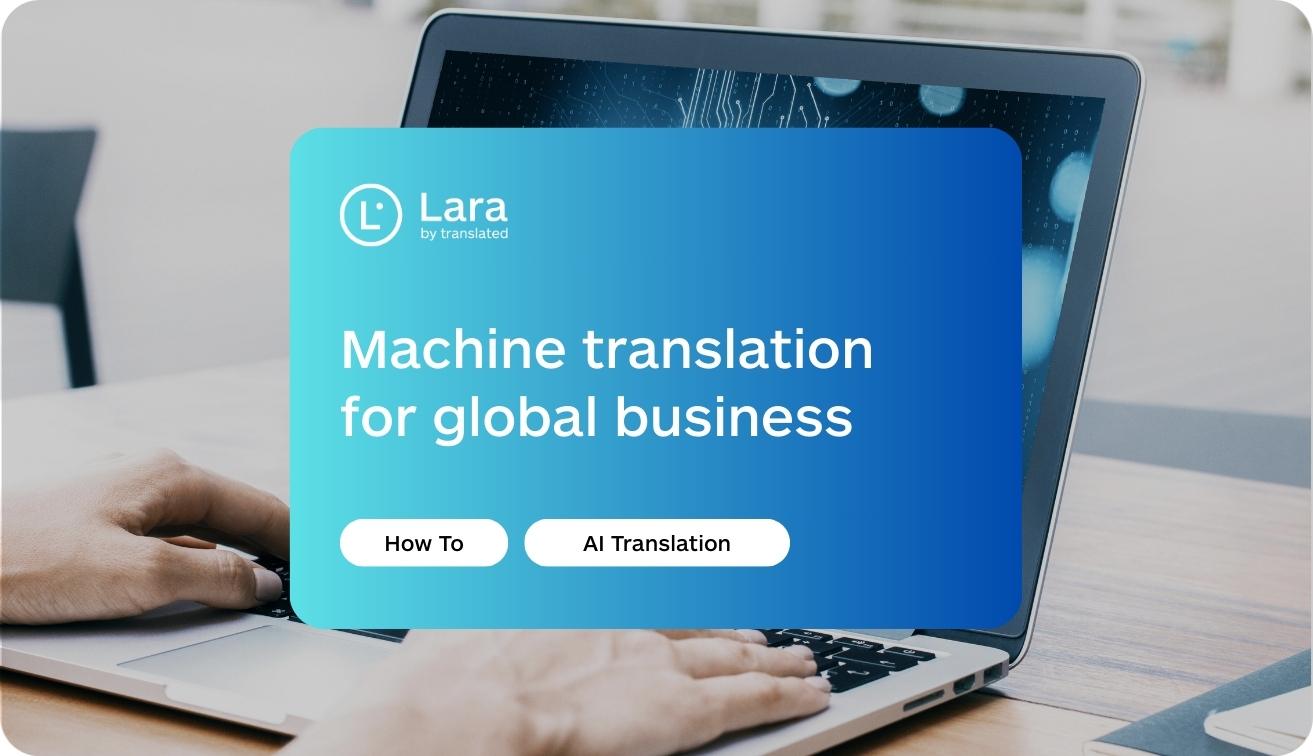Website localization is far more than simply translating text from one language to another. It’s about creating an authentic, culturally relevant experience that resonates with your target audience in each market you serve. When done effectively, website localization for business growth can dramatically expand your reach, boost customer engagement, and drive significant revenue from international markets.
In today’s globalized economy, limiting your business to a single language market means leaving substantial opportunities untapped. With over 4.9 billion internet users worldwide speaking hundreds of different languages, the potential to expand business through website translation has never been greater.
This comprehensive guide will walk you through the essential steps to successfully localize your website and position your business for international success.
What is website localization and why does it matter?
Website localization is the process of adapting your website content, design, and functionality to match the linguistic, cultural, and technical preferences of users in different target markets. Unlike simple translation, localization considers cultural nuances, local preferences, regulations, and user behaviors to create an experience that feels native to each local audience.
The benefits of website localization are substantial:
- Expanded market reach: Access new customer bases and revenue streams in international markets
- Improved user experience: Create a seamless, intuitive experience for visitors regardless of location
- Higher conversion rates: Users are more likely to purchase when content is in their native language
- Enhanced brand perception: Demonstrate commitment to serving local markets authentically
- Competitive advantage: Differentiate from competitors who haven’t properly localized their online presence
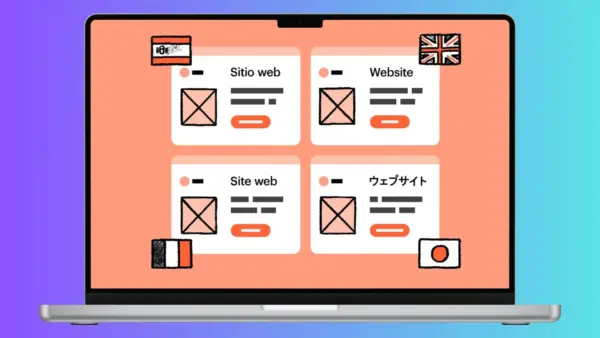
Research by Common Sense Advisory shows that 72.4% of consumers are more likely to buy a product when information is available in their own language, while 56.2% say that the ability to obtain information in their language is more important than price. These statistics highlight why website translation and localization is no longer optional for businesses with global ambitions.
Creating a comprehensive localization strategy for web growth
Before diving into the technical aspects of localization, you need a well-defined strategy that aligns with your business objectives. And generally about website localization for businesses.
A successful localization strategy begins with thorough market research to identify which markets offer the greatest potential for your products or services. Consider factors like market size, competition, cultural fit, and purchasing power. Prioritize regions where you already see organic traffic or customer interest, as this indicates existing demand.
Once you’ve identified your target markets, develop a clear roadmap for your business website localization efforts. This should include:
- Target languages and regions: Which specific markets will you enter first, second, and so on?
- Content prioritization: Which pages and content types should be localized first?
- Resource allocation: What budget, team members, and technologies will you need?
- Quality standards: How will you ensure high-quality translations and cultural adaptations?
- Measurement framework: What metrics will define success for your localization efforts?
Your localization strategy should also account for regional preferences in website navigation patterns, design aesthetics, and purchasing behaviors. For example, Japanese websites often contain more information on a single page compared to Western sites, while Middle Eastern audiences expect right-to-left text orientation.
Essential steps to localize your business website
1. Conduct thorough market research
Before translating a single word, gain deep insights into your target markets. This includes:
- Competitive analysis: Study how competitors have approached localization in your target markets
- Cultural research: Understand cultural norms, taboos, holiday calendars, and color associations
- User behavior analysis: Research how local users interact with websites in your industry
- Regulatory requirements: Identify any legal compliance issues (GDPR in Europe, LGPD in Brazil, etc.)
This research will inform every aspect of your localization efforts, helping you avoid cultural missteps and ensure compliance with local regulations.
2. Prepare your website for internationalization
Internationalization (i18n) is the technical foundation that makes localization possible. This process involves restructuring your website code and architecture to support multiple languages and regional variations.
Key internationalization steps include:
- Separating text from code: Ensure all translatable content is stored in resource files rather than hardcoded
- Implementing Unicode (UTF-8) encoding: Support character sets from all languages
- Creating flexible layouts: Design that accommodates text expansion (many languages require 20-30% more space than English)
- Building responsive designs: Ensure proper display across devices common in target markets
Without proper internationalization, localization becomes significantly more complex and costly. Tools like Lara Translate can help streamline this process by automatically detecting and extracting translatable content from your website structure.
3. Plan your URL structure strategy
How you structure URLs for different languages impacts both user experience and SEO. The three main approaches are:
- Country-code top-level domains (ccTLDs): example.fr, example.de
- Subdomains: fr.example.com, de.example.com
- Subdirectories: example.com/fr/, example.com/de/
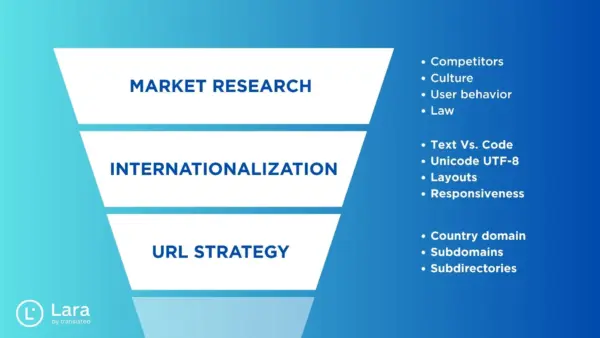
Each approach has pros and cons:
| Strategy | SEO Impact | Implementation Complexity | User Recognition | Best For |
| ccTLDs | Strongest geo-targeting | Highest | Clearest country association | Large enterprises with strong local presence |
| Subdomains | Moderate | Medium | Good language separation | Mid-sized businesses with multiple markets |
| Subdirectories | Easier to maintain domain authority | Lowest | Less clear country targeting | Small-to-medium businesses, early global expansion |
For most businesses beginning their localization journey, subdirectories offer the best balance of SEO benefits and implementation simplicity.
4. Implement hreflang tags for multilingual SEO
Hreflang tags are crucial HTML attributes that tell search engines which language and geographical region a specific page targets. This prevents duplicate content issues and ensures users see the most relevant version of your site.
Each localized page should include the complete set of hreflang tags, pointing to all language versions including itself. This creates a network of references that search engines use to understand the relationship between your localized pages.
5. Adapt content beyond translation
Effectively translating websites for global users goes far beyond word-for-word conversion. Website localization best practices include adapting:
- Visual elements: Images, videos, and graphics should reflect local audiences and cultural norms
- Currencies and payment methods: Display local currencies and offer preferred payment options
- Date formats: Switch between MM/DD/YYYY and DD/MM/YYYY as appropriate
- Number formats: Adapt decimal separators (period vs. comma) and digit grouping
- Legal content: Privacy policies, terms of service, and compliance notices
- Contact information: Local phone numbers, addresses, and support hours
The goal is to create an international user experience that feels completely natural to local visitors. This might mean entirely different content for some markets rather than direct translations.
6. Leverage technology for efficient localization
Modern localization requires specialized tools to manage the complexity of multilingual content. A robust technology stack typically includes:
- Translation Management System (TMS): Centralize translation workflow and asset management
- Content Management System (CMS) with multilingual support: Manage content across languages
- Translation Memory (TM): Store previously translated segments to improve consistency and reduce costs
- Machine Translation (MT): Provide initial translation drafts for human review
Lara Translate offers a powerful solution for businesses looking to streamline their website localization process. With its advanced AI translation capabilities and Model Context Protocol (MCP) technology, Lara Translate goes beyond simple word-for-word translation to deliver culturally appropriate, contextually accurate content. The platform’s sophisticated algorithms understand industry-specific terminology and maintain your brand voice across languages, significantly reducing the time and resources needed for high-quality localization. Whether you’re expanding into two markets or twenty, Lara Translate helps ensure your website resonates with local audiences while maintaining consistent brand messaging.
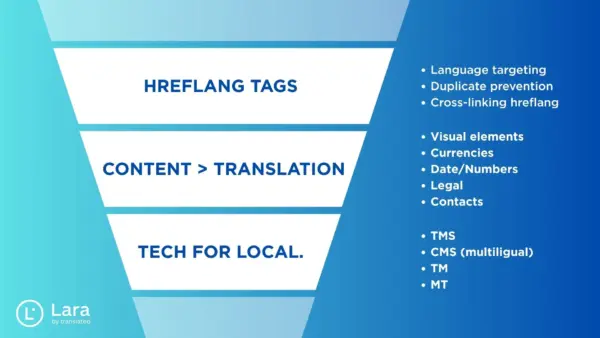
7. Optimize for local search engines
How website translation improves SEO is often underestimated. Beyond making content accessible to international audiences, proper localization dramatically improves your search visibility in target markets.
Local SEO considerations include:
- Keyword research for each market: Don’t simply translate keywords; research terms local users actually search for
- Local search engine optimization: Some markets use search engines other than Google (Baidu in China, Yandex in Russia)
- Local backlink strategies: Build links from local websites and directories
- Local business listings: Register with country-specific business directories
Remember that search behaviors vary significantly across cultures. What works in your home market may not resonate with users in other regions.
8. Test thoroughly before launch
Before going live with your localized website, conduct comprehensive testing to identify and resolve issues:
- Linguistic testing: Verify translation quality, cultural appropriateness, and brand consistency
- Functional testing: Ensure all features work correctly across languages
- Visual testing: Check for layout issues, especially with languages that expand or use different scripts
- User testing: Get feedback from native speakers and local users
Pay particular attention to localized UX elements like forms, checkout processes, and interactive features, as these often contain subtle localization errors that can impact conversion rates.
9. Launch and continuously improve
Website localization is not a one-time project but an ongoing process. After launch:
- Monitor performance metrics: Track user engagement, conversion rates, and other KPIs by language/region
- Gather user feedback: Collect input directly from users in each market
- Update content regularly: Ensure all markets receive timely updates and new content
- Optimize based on data: Use analytics to identify improvement opportunities
Regular content updates are particularly important for maintaining SEO performance and user engagement across all your localized versions.
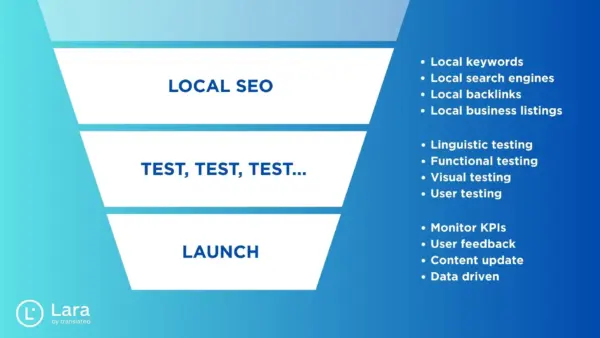
Measuring the impact of your localization efforts
To justify continued investment in localization, track key metrics that demonstrate business impact:
- Traffic growth from target markets
- Engagement metrics by language (time on site, pages per session)
- Conversion rates compared to pre-localization
- Customer acquisition costs in new markets
- Revenue and customer lifetime value by region
Establish baseline measurements before launching localized versions, then track improvements over time. This data not only demonstrates ROI but also helps identify which markets deserve additional investment.
Common challenges and how to overcome them
Even with careful planning, website localization presents several challenges:
Challenge 1: Content maintenance across multiple languages Solution: Implement a centralized content management system with workflow features that streamline updates across languages.
Challenge 2: Maintaining consistent brand voice Solution: Create detailed style guides for each language and establish glossaries of approved terminology.
Challenge 3: Technical limitations of existing website Solution: Consider a phased approach, starting with key landing pages while working on broader internationalization.
Challenge 4: Cost management Solution: Prioritize markets with highest potential ROI and use a combination of machine translation and human editing to optimize costs.
Challenge 5: Finding qualified translators with industry knowledge Solution: Partner with specialized localization service providers or use platforms that connect you with pre-vetted translators.
Getting started with your localization journey
Website localization for business growth doesn’t need to be overwhelming. Start with these practical steps:
- Analyze your current international traffic to identify promising markets
- Select one high-potential market for your initial localization effort
- Audit your website for internationalization readiness
- Develop a localization roadmap with clear milestones and responsibilities
- Select appropriate localization technologies and partners
- Begin with high-impact pages (homepage, key product pages, checkout)
- Test thoroughly with native speakers before launch
- Monitor performance and gather user feedback
- Optimize and expand to additional markets based on results
Remember that successful localization is a journey rather than a destination. The most successful global businesses continuously refine their approach based on performance data and evolving market conditions.
FAQ: Website Localization for Business Growth
What’s the difference between translation and localization?
Translation is the process of converting text from one language to another while preserving meaning. Localization, however, is more comprehensive—it adapts the entire user experience to feel natural and appropriate for the target culture. This includes translation plus adapting images, design elements, currencies, date formats, legal requirements, and cultural references to meet local expectations and preferences.
How much does website localization typically cost?
The cost of website localization for business varies widely depending on factors such as the number of target languages, volume of content, complexity of your website, and quality requirements. Simple translation-only approaches might cost $0.05-0.15 per word, while full localization with professional translators, cultural adaptation, and technical implementation can range from a few thousand dollars for small sites to tens of thousands for complex, content-heavy websites. Many businesses find that using AI translation like Lara Translate for initial drafts, followed by human review, provides the best balance of quality and cost-efficiency.
How long does the website localization process usually take?
Timeline depends on scope, but typically ranges from 1-3 months for a standard business website targeting 2-3 languages. Simple sites with minimal content may be completed in 2-4 weeks, while complex e-commerce platforms with thousands of products might take 6+ months. A phased approach—starting with key revenue-generating pages—can help you see returns faster while the complete localization continues.
Should I use machine translation or human translators for my website?
The most effective approach is typically a hybrid model. Modern AI translation tools like Lara Translate provide excellent initial translations, especially for straightforward content. However, human review and editing are still essential for marketing content, legal terms, and culturally sensitive material. This hybrid approach balances quality, cost, and time efficiency. For highly technical or creative content, specialized human translators with industry knowledge remain invaluable.
Which parts of my website should I localize first?
Prioritize pages that drive the most conversions and revenue—typically the homepage, product/service pages, and checkout process. Also localize content that addresses key customer questions or objections. Analytics can help identify which pages international visitors already access most frequently. Legal content (privacy policies, terms of service) should be professionally localized to ensure compliance with local regulations. Lower-priority content like archived blog posts can be addressed in later phases.
How do I handle customer support for multiple languages?
Start by translating your FAQ and help center content to address common questions. For direct support, options include: hiring multilingual customer service representatives, partnering with localization service providers that offer customer support services, implementing a tiered support approach (with self-service options in all languages but human support in select languages), or using AI-powered translation tools integrated with chatbots for initial support. The approach should align with your budget and the importance of each market to your business.
How can I ensure my localized website ranks well in local search engines?
For strong multilingual SEO, conduct language-specific keyword research rather than simply translating your existing keywords. Implement proper hreflang tags to help search engines understand language relationships between pages. Create a clear URL structure that indicates language/region. Build local backlinks from relevant websites in each target market. Consider local hosting for improved page speed in distant markets. Most importantly, ensure your content truly resonates with local audiences—search engines increasingly reward quality user experiences over technical optimizations.
This article is about:
- Why website localization for business is essential for business growth in today’s global digital landscape
- Key steps and technical foundations for successfully localizing your website
- The measurable benefits of website localization for business, from increased conversions to improved user experience
- Common challenges in the localization process and how to effectively overcome them


